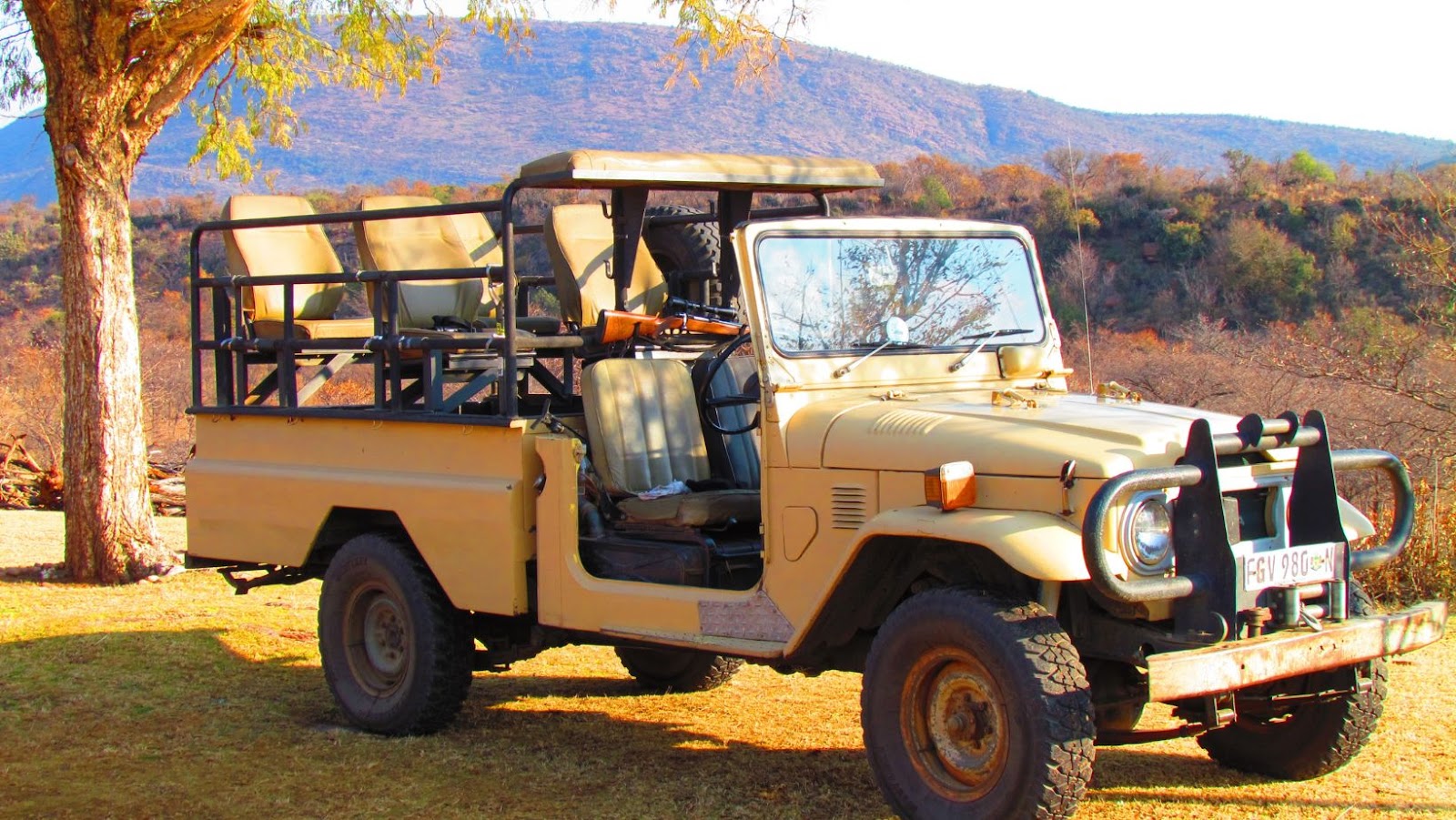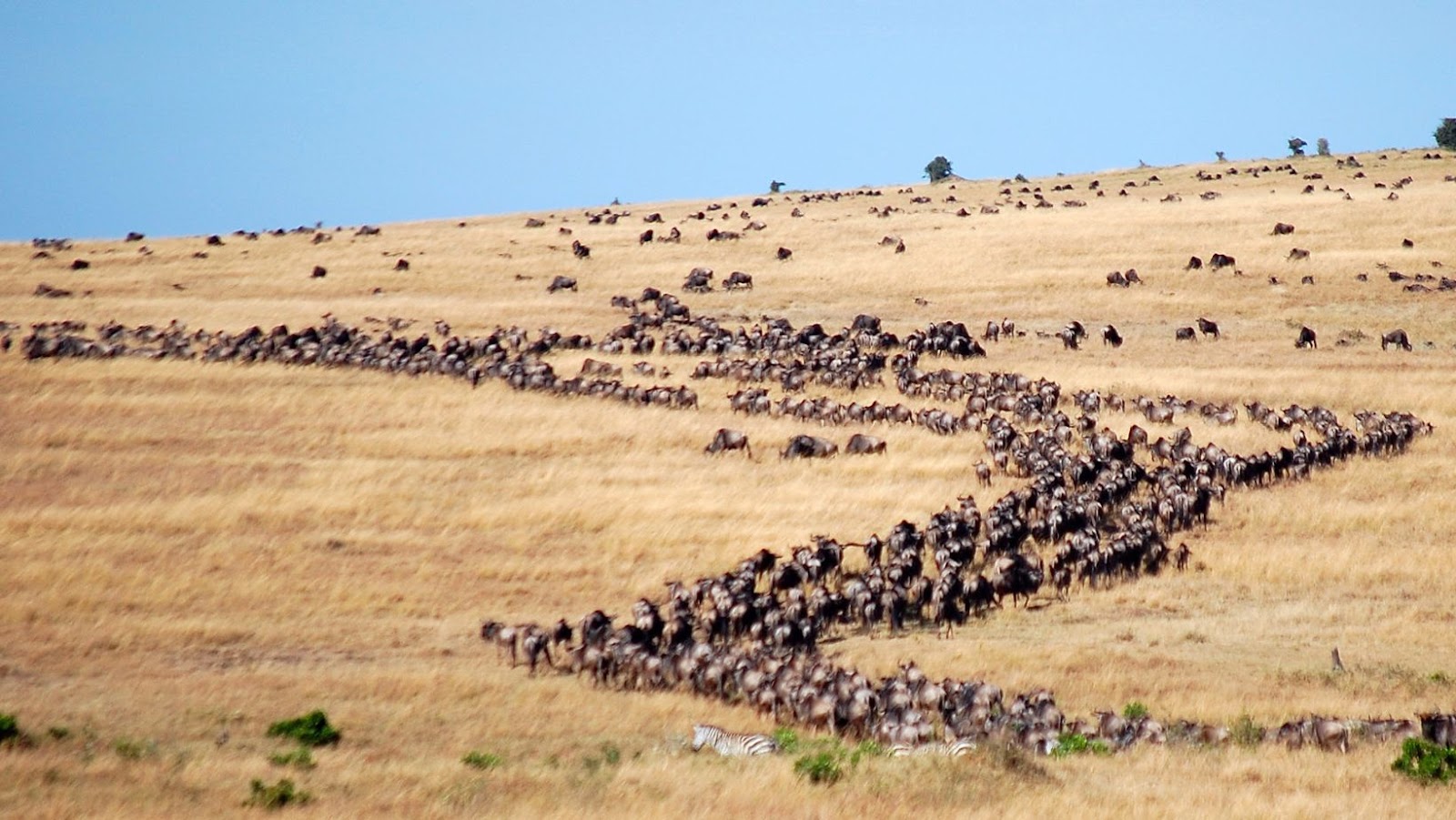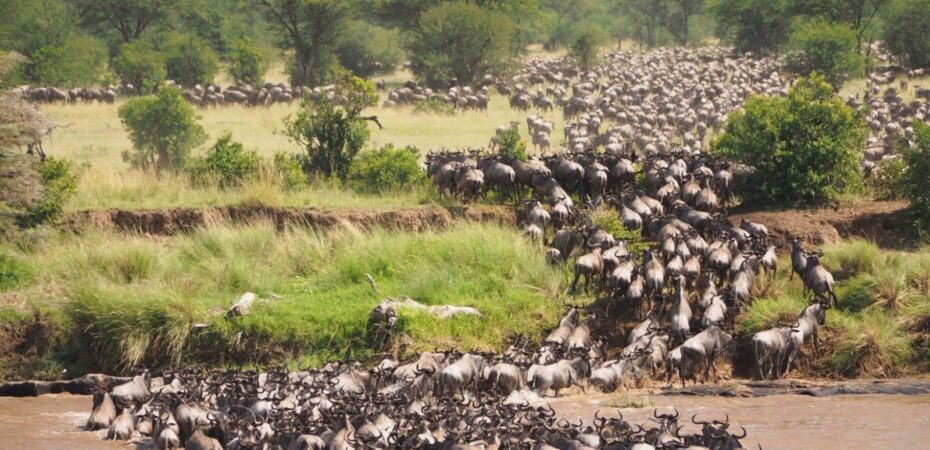The Great Migration, also known as the Great Wildebeest Migration, is the largest seasonal movement of animals on the planet. It is a true spectacle of nature: millions of wildebeest and hundreds of thousands of zebras, antelope, and other animals move clockwise through the huge Serengeti-Mara ecosystem, following rainfall and fresh grass and overcoming many challenges on their way. The gigantic herds of migrating animals can even be seen from space! This wildlife drama is one of the most iconic sights of Africa, and many tourists travel to Tanzania and Kenya to experience it in person. In this brief article, we will learn more about the Great Migration and answer a number of common questions: What is the best time to see the Great Migration? Where does it start and end? How to plan your safari trip to see the Great Migration in Tanzania? Where to stay and what else to consider beforehand?
Great Wildebeest Migration crossing the Mara river at Serengeti National Park – Tanzania
The Yearly Cycle of the Great Migration
So when does the Great Migration take place? All year round! The huge herds of herbivore animals move through Tanzania and a part of Kenya throughout the year in pursuit of fresh pastures and water, as they have been doing for many centuries or even millennia. Naturally, predators like lions, hyenas, cheetahs, and crocodiles follow along or wait in the water for dinner to come to them. The lucky traveler who got the chance to witness the unfiltered drama of one of the most impressive wildlife displays on the planet will definitely cherish those memories for years to come. The annual movement of big herds depends on the rainfall pattern and can vary from year to year. However, migration still has a general pattern, and we can predict how the animals will move and where most of them will be month by month (given that the rainfall is consistent). Here we’ll briefly look at the pattern of their movement so that you can decide when to go on your Great Migration safari and witness this stunning wildlife drama.
January – March
While there is no clear “start” of the Great Migration, we may call the Calving Season the beginning of the circle of life. It’s the time when literally about half a million calves are being born in the period of only 4-6 weeks! In February and March, the migration passes through the southern parts of Serengeti National Park and Ndutu – a region in Ngorongoro Conservation Area in Tanzania. It is a great time to see the newborn wildebeest and zebras walking with the herds and even running around just a few days after being born! Naturally, the huge quantities of calves attract predators who look for easy prey. For those who want to see the most predator-prey interactions, this gives you the highest chances to catch a glimpse of the hunting scenes.
April – June
April is marked by the start of the rainy season in Tanzania, and the herds move north to the central part of Serengeti named Seronera. Up until mid-June, the animals continue to move to the northwest, to the regions named Western Corridor and Grumeti. On their way, they must cross the crocodile-infested Mbalageti and Grumeti rivers, which typically happens in the span of 1 to 2 weeks in June. While not as dramatic as the Mara river crossing, these two crossings attract film crews from all over the world. Seeing it with your own eyes, however, is totally different than watching a video on a screen.

July
As June gives way to July, the herds continue to move to an even more difficult obstacle: the Mara river in the north of Serengeti with its steep banks and dangerous depths. These crossings are among the most spectacular wildlife events in the world. This period from July to mid-August is considered the peak of the Great Migration safari tourism. In addition, around July, you are likely to encounter really good weather – sunny, dry, and not too hot. Numerous safari groups come to see the crossing of the Mara river, and it may get rather crowded. If you want to see one of the most iconic events of the Great Migration in Tanzania, be prepared to book at least a year in advance.
August – September
By mid-August, many herds have crossed the Mara river and spread through the rich pastures of Masai Mara in Kenya, while many still remain in northern Serengeti in Tanzania. By September and October chaos and drama of the river crossing, which can cause great loss of life in some years, comes to an end. But the animals would have to cross the great streams again on their way back south.
October – December
In this period, the herds start to move back from Kenya’s Maasai Mara National Reserve through the Lolindo area towards the Ndutu plains in the south of Serengeti. The animals spread over a huge area and prepare for the calving season when the cycle begins again.
How to Plan Your Stay in Tanzania During the Great Migration
If you’ve decided to travel Tanzania to see the Great Migration, it’s important to plan well in advance. If you want to go on safari during the peak season (July, August, and September) and secure your preferred operator and lodges/camps, then it is recommended to book 12 or even 18 months out. If you can wait until October – November, it’s likely that you will encounter fewer crowds and enjoy lower rates. Since the Great Migration is a never-ending cycle, you will have a great experience whenever you choose to go. November to December is often considered the low season for Wildebeest Migration safari in Tanzania, which means you’d need to book only a few months in advance (we recommend 3-4 months in advance to be safe). The Calving Season (January – March) can also be quite busy, so booking at least 6 months out or earlier is a very good idea. The movement of herds can vary year to year depending on the weather, but experienced safari guides will do their best to find the most interesting wildlife sightings and bring you to them.

The Best Safari Camps and Lodges to Stay During the Great Wildebeest Migration in Tanzania
There are many camps and lodges situated in picturesque areas of Tanzania throughout the path of the Wildebeest Migration. So when planning your accommodation, it’s important to keep in mind the timing. Usually, you’ll see detailed descriptions of the best time to visit every lodge, included facilities, and other possible sights of interest available nearby on the lodge’s website – but typically, your tour operator will assist you will all the details. If you want to get a taste of different safari experiences, ask your safari manager to offer you several lodges with differing features. You can stay a couple of nights in a classic safari tent but pamper in luxury on your final days of stay in Serengeti. When it comes to planning a safari in Tanzania, the diversity of options is overwhelming: there is an abundance of lodges of various styles and comfort levels. You can stay in luxurious stone-built lodges or try out a more authentic tented-lodge experience. All accommodation types are available in different comfort categories.
Note that while some camps occupy the same place all year round, others are “moving camps” that follow the migration of animals by relocating two or three times a year. But either way, you can expect high standards of service from most camps – your stay in Tanzania will be comfortable and safe. Here’s a list of recommended lodges in different regions of Serengeti of various levels of luxury from 3 to 5 stars:
In Ndutu:
– 3,5* Nyikani Migration Camp
– 4* Lake Masek Tented Lodge; (TWC)
– 5* Serengeti Migration Camp (Nomad)
In South Serengeti:
– 3* Serengeti Woodlands Camp(Karibu)
– 4* Kusini Safari Camp (Sanctuary Retreats)
– 5* Serengeti Migration Camp (Nomad)
In Central Serengeti:
– 3,5* Serengeti Sound of Silence Camp
– 3,5* Serengeti Sametu Camp (Karibu)
– 4* Kubu Kubu Tented Lodge (TWC)
– 5* Elewana Pioneer Camp
In North Serengeti:
– 3,5* Nyikani Migration Camp
– 4* Mara Under Canvas (TWC)
– 5* Elewana Migration Camp, (Elewana)
– 5* Kuria Hills Lodge (Lemala)
– 5* Serengeti Klein’s Camp by &Beyond (best in September-October)
– 5* Lamai Serengeti (Nomad)
Other Things to Consider
Serengeti is located at least a half-day drive away from the city of Arusha, the place where all Tanzania safari tours typically start. So a very short stay might not be optimal as you will spend much of it in transit. However, it is possible to take the option of flying to the national park on a plane over the magnificent landscapes of Tanzania and save a lot of time. In addition, you might consider combining your Great Migration safari trip with visits to nearby national parks such as Arusha, Ngorongoro, and Tarangire.
When planning your safari in Tanzania, remember that Serengeti is not only about the Great Migration. These grasslands are always bustling with life. Impressive predators like cheetahs, leopards, and lions don’t change their location during the year, and they are really exciting to watch. Of course, you can encounter other great African animals, such as buffalos, elephants, giraffes, and many others. No matter when you visit Serengeti, you’ll always have an unforgettable adventure.


 By
By 




